Emergency Supplies
Having a few lightweight emergency supplies that can help you spend the night outdoors, if required, can save you and your companions.
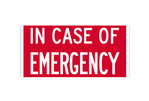
Here's the type of emergency supplies that we like for Hiking and why we like them:
- Locking Knife
- Small Flashlight - Micro USB Rechargeable
- Paracord Bracelet
- Emergency Whistle
- Water Filtration Life Straw
- Disposable Butane Lighter
- Waterproof Matches
- Waterproof Firestarter Blocks
- Waterproof Match Case
- Signaling Mirror
- Thermal Survival Blanket
- Survival Skill Cards
- Note: click on any photo to enlarge it
Locking Knife
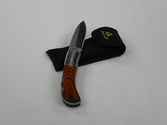
Greatland - 3" Locking Blade with Sheath
In an emergency situation one of the most common tools that you need is a knife. But since you may need it for a variety of reasons (e.g. making a shelter, making tinder, cutting paracord, etc.,) you don’t want it to be a flimsy knife that can accidently close-up or snap off. What you need is a strong locking blade knife. The criteria that we use to evaluate locking knifes are: 1) size of blade, 2) strength of blade, 3) ability of blade to retain an edge, 4) feel in your hand, and 5) price. We’ve had our 3” Greatland knife for a long time and have kept it because the blade is a good length for cutting while staying firm, has a strong lock and a strong handle. Although you can no longer buy this knife, you can buy locking-blade knives like this at Amazon.
In an emergency situation one of the most common tools that you need is a knife. But since you may need it for a variety of reasons (e.g. making a shelter, making tinder, cutting paracord, etc.,) you don’t want it to be a flimsy knife that can accidently close-up or snap off. What you need is a strong locking blade knife. The criteria that we use to evaluate locking knifes are: 1) size of blade, 2) strength of blade, 3) ability of blade to retain an edge, 4) feel in your hand, and 5) price. We’ve had our 3” Greatland knife for a long time and have kept it because the blade is a good length for cutting while staying firm, has a strong lock and a strong handle. Although you can no longer buy this knife, you can buy locking-blade knives like this at Amazon.
Small Flashlight - Micro USB Rechargeable
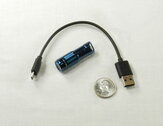
MecArmy X2S Stainless Steel LED Flashlight
Just like it’s a good idea to have a small light-weight water purification device with you on a day hike - even if you never intend to use it - it's also a great idea to have a small flashlight with you too. Once again, balancing the need to be prepared for an unlikely occurrence with the weight and bulk of carrying “just one more thing” in your day pack is key. To achieve this balance we think that packing a small rechargeable LED flashlight is the best way to go. The criteria that we use to evaluate small flashlights are: 1) maximum brightness, 2) distance, 3) run time, 4) on/off switch mechanism, 5) construction material strength, 6) waterproof specifications, 7) rechargeability, and 8) price.
After looking at several of the best small flashlights on the market we purchased the MecArmy X2S Stainless Steel LED Flashlight. This tiny light measures only 1.75 inches long by .57 inches wide and weighs only .75 ounces – but will throw a maximum of 130 lumens almost 200 feet. The flashlight is made from high grade 304 stainless steel with a scratch resistant physical vapor deposition (PVD) coating. The actual light is a CREE XP-G2 LED with a micro USB rechargeable10180 lithium ion battery. The battery is rechargeable in 1 hour using any USB port device - like your phone charger. The max run time for the flashlight is 6 hours. The flashlight’s casing is impact resistant up to 5 feet, waterproof down to 7 feet (IPX8 Standard) and comes with a reliable twist switch for quick, one-handed operation. You can buy this small micro USB rechargeable flashlight at Amazon.
Just like it’s a good idea to have a small light-weight water purification device with you on a day hike - even if you never intend to use it - it's also a great idea to have a small flashlight with you too. Once again, balancing the need to be prepared for an unlikely occurrence with the weight and bulk of carrying “just one more thing” in your day pack is key. To achieve this balance we think that packing a small rechargeable LED flashlight is the best way to go. The criteria that we use to evaluate small flashlights are: 1) maximum brightness, 2) distance, 3) run time, 4) on/off switch mechanism, 5) construction material strength, 6) waterproof specifications, 7) rechargeability, and 8) price.
After looking at several of the best small flashlights on the market we purchased the MecArmy X2S Stainless Steel LED Flashlight. This tiny light measures only 1.75 inches long by .57 inches wide and weighs only .75 ounces – but will throw a maximum of 130 lumens almost 200 feet. The flashlight is made from high grade 304 stainless steel with a scratch resistant physical vapor deposition (PVD) coating. The actual light is a CREE XP-G2 LED with a micro USB rechargeable10180 lithium ion battery. The battery is rechargeable in 1 hour using any USB port device - like your phone charger. The max run time for the flashlight is 6 hours. The flashlight’s casing is impact resistant up to 5 feet, waterproof down to 7 feet (IPX8 Standard) and comes with a reliable twist switch for quick, one-handed operation. You can buy this small micro USB rechargeable flashlight at Amazon.
Paracord Bracelet
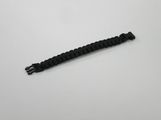
S.E. 7 Strand Survival Paracord Bracelet
If you need to make a splint or an improvised shelter while hiking then having paracord is invaluable. Rather than carry a hasp of rope it’s easier to just wear a paracord bracelet on your wrist. The criteria that we use to evaluate paracord bracelets are: 1) length of paracord, 2) strength of paracord, and 3) weight. We like the S.E. 7 Strand Survival Paracord Bracelet because it has 8 feet of 430 pound paracord but only weighs 1 oz. You can buy paracord bracelets at Amazon.
If you need to make a splint or an improvised shelter while hiking then having paracord is invaluable. Rather than carry a hasp of rope it’s easier to just wear a paracord bracelet on your wrist. The criteria that we use to evaluate paracord bracelets are: 1) length of paracord, 2) strength of paracord, and 3) weight. We like the S.E. 7 Strand Survival Paracord Bracelet because it has 8 feet of 430 pound paracord but only weighs 1 oz. You can buy paracord bracelets at Amazon.
Emergency Whistle
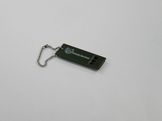
Grizzly Survival Whistle
In an emergency situation where you need to get the attention of other people or rescuers you need emergency supplies that will attract them with both sound and visual signals. Since the sounds from yelling will not carry very far in the backcountry a better solution is a survival whistle. The criteria that we use to evaluate survival whistles are: 1) volume of sound, 2) pitch of sound, 3) durability, 4) size and 5) weight. We like the Grizzly Survival Whistle because it is small and light and very loud. In fact this is the same type of whistle that the American Red Cross hands out to those in areas with severe weather - so it's an emergency whistle whose sound is easily recognized by first-responders. You can buy this emergency whistle at Amazon.
In an emergency situation where you need to get the attention of other people or rescuers you need emergency supplies that will attract them with both sound and visual signals. Since the sounds from yelling will not carry very far in the backcountry a better solution is a survival whistle. The criteria that we use to evaluate survival whistles are: 1) volume of sound, 2) pitch of sound, 3) durability, 4) size and 5) weight. We like the Grizzly Survival Whistle because it is small and light and very loud. In fact this is the same type of whistle that the American Red Cross hands out to those in areas with severe weather - so it's an emergency whistle whose sound is easily recognized by first-responders. You can buy this emergency whistle at Amazon.
Water Filtration Life Straw
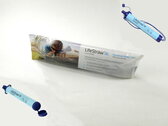
Lifestraw Personal Water Filter
If you carry water with you on a day hike you probably won’t need to locate any additional water to drink. However, in an emergency you may have to. Because of this we think it’s a good idea to have the ability to purify water with you. Of course the problem is how to balance the need to be prepared for an unlikely occurrence with the weight and bulk of carrying “just one more thing” in your day pack. Because of this we think that having a life straw is probably the best way to go. The criteria that we use to evaluate life straws are: 1) purification level, 2) ease of use, 3) ease of drinking the water through the straw and 4) price.
If you look at our Camping/Hydration page you’ll see that we advocate a “tiered” system that allows you to carry some water and then store and use other local water that you find while camping. For hiking, we advocate that you carry the all water that you will need – but have a backup just in case. However, you obviously don’t want to carry all of the options that you might have when camping since your water needs are certainly less - and the weight and bulk constraints of your day pack are less. Because of this we carry a Lifestraw Personal Water Filter with us on hikes. The Lifestraw’s microfiltration membrane removes 99.999999% of waterborne bacteria (including E. coli and salmonella), and 99.999% of waterborne parasites (including giardia and cryptosporidium). It also removes the smallest microplastics, dirt, sand and cloudiness (down to 1 micron), and reduces turbidity down to 0.2 microns. The LifeStraw will provide 4,000 liters (1,000 gallons) of clean and safe drinking water with proper use and maintenance, has an unlimited shelf life, and has been tested all over the world in the harshest conditions. The LifeStraw measures 8.66 x 0.98 inches and weighs less than 2 ounces – making it easy to add to your day pack. It’s also pretty trivial to clean and store.
Some people complain that it is hard to actually suck the water through the Lifestraw – and we will admit that using a Lifestraw is harder than using a “normal” straw since the filter inhibits the flow of water – but we think that this is a small price to pay for being able to drink filtered water directly from the source in an emergency situation. As shown on our Camping/Hydration page we also have a Sawyer Products Mini Water Filtration System in our gear inventory and like it because it has a 16-ounce reusable squeeze pouch to go with the filter. This pouch makes it easier to drink the water since you can push it (by squeezing) and pull it (by sucking) through the filter simultaneously – making drinking a little easier; but you actually have to fill the pouch with water instead of drinking directly from the source. You can buy these life straws at Amazon.
If you carry water with you on a day hike you probably won’t need to locate any additional water to drink. However, in an emergency you may have to. Because of this we think it’s a good idea to have the ability to purify water with you. Of course the problem is how to balance the need to be prepared for an unlikely occurrence with the weight and bulk of carrying “just one more thing” in your day pack. Because of this we think that having a life straw is probably the best way to go. The criteria that we use to evaluate life straws are: 1) purification level, 2) ease of use, 3) ease of drinking the water through the straw and 4) price.
If you look at our Camping/Hydration page you’ll see that we advocate a “tiered” system that allows you to carry some water and then store and use other local water that you find while camping. For hiking, we advocate that you carry the all water that you will need – but have a backup just in case. However, you obviously don’t want to carry all of the options that you might have when camping since your water needs are certainly less - and the weight and bulk constraints of your day pack are less. Because of this we carry a Lifestraw Personal Water Filter with us on hikes. The Lifestraw’s microfiltration membrane removes 99.999999% of waterborne bacteria (including E. coli and salmonella), and 99.999% of waterborne parasites (including giardia and cryptosporidium). It also removes the smallest microplastics, dirt, sand and cloudiness (down to 1 micron), and reduces turbidity down to 0.2 microns. The LifeStraw will provide 4,000 liters (1,000 gallons) of clean and safe drinking water with proper use and maintenance, has an unlimited shelf life, and has been tested all over the world in the harshest conditions. The LifeStraw measures 8.66 x 0.98 inches and weighs less than 2 ounces – making it easy to add to your day pack. It’s also pretty trivial to clean and store.
Some people complain that it is hard to actually suck the water through the Lifestraw – and we will admit that using a Lifestraw is harder than using a “normal” straw since the filter inhibits the flow of water – but we think that this is a small price to pay for being able to drink filtered water directly from the source in an emergency situation. As shown on our Camping/Hydration page we also have a Sawyer Products Mini Water Filtration System in our gear inventory and like it because it has a 16-ounce reusable squeeze pouch to go with the filter. This pouch makes it easier to drink the water since you can push it (by squeezing) and pull it (by sucking) through the filter simultaneously – making drinking a little easier; but you actually have to fill the pouch with water instead of drinking directly from the source. You can buy these life straws at Amazon.
Disposable Butane Lighter
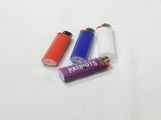
Disposable BIC Butane Lighter
If you read lots of hiking, camping and survival sites and forums there are thousands of articles on starting fires in the backcountry. We agree that starting a fire is a vital skill, but using flint and steel or making a bow drill should not be Plan A. Plan A should be using a butane lighter since that’s the quickest and easiest approach. The criteria that we use to evaluate butane lighters are: 1) dependability of ignition, 2) height of flame and 3) number of uses before the fuel is depleted. For us the best solution to meet this need is the disposable BIC lighter. They are cheap, dependable (unless they get wet) and have adjustable flame levels. If they don’t work you can always move to plan B – but why not start with the easiest approach. You can buy all sorts of BIC butane lighters at Amazon or your local stores.
If you read lots of hiking, camping and survival sites and forums there are thousands of articles on starting fires in the backcountry. We agree that starting a fire is a vital skill, but using flint and steel or making a bow drill should not be Plan A. Plan A should be using a butane lighter since that’s the quickest and easiest approach. The criteria that we use to evaluate butane lighters are: 1) dependability of ignition, 2) height of flame and 3) number of uses before the fuel is depleted. For us the best solution to meet this need is the disposable BIC lighter. They are cheap, dependable (unless they get wet) and have adjustable flame levels. If they don’t work you can always move to plan B – but why not start with the easiest approach. You can buy all sorts of BIC butane lighters at Amazon or your local stores.
Waterproof Matches
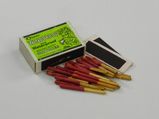
Coghlan's Waterproof Matches
If Plan A (a butane lighter) doesn’t work to start a fire, then Plan B should be waterproof matches. Once again, items like a ferro rod are great – but still not Plan A or plan B. The criteria that we use to evaluate waterproof matches are: 1) ability to light after getting wet and 2) ability to light in the wind. Coughlan’s has a very detailed line of fire making products and their waterproof matches fit right in with the rest of their products. Theses matches work great – just don’t expect them to work after being soaked for a long period of time. With matches “waterproof” probably really means “water resistant”. You can buy these matches at Amazon; or Coghlan's 1170 Storm Matches if you are really serious.
If Plan A (a butane lighter) doesn’t work to start a fire, then Plan B should be waterproof matches. Once again, items like a ferro rod are great – but still not Plan A or plan B. The criteria that we use to evaluate waterproof matches are: 1) ability to light after getting wet and 2) ability to light in the wind. Coughlan’s has a very detailed line of fire making products and their waterproof matches fit right in with the rest of their products. Theses matches work great – just don’t expect them to work after being soaked for a long period of time. With matches “waterproof” probably really means “water resistant”. You can buy these matches at Amazon; or Coghlan's 1170 Storm Matches if you are really serious.
Waterproof Firestarter Blocks
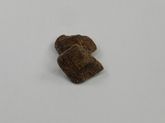
Coghlan's Waterproof Fire Sticks
Regardless of what you use for the initial flame (e.g. butane lighter, waterproof matches, or Plan C) to make sure that you can start a fire in an emergency situation you need all the help that you can get. That’s where waterproof firestarter blocks come in. The criteria that we use to evaluate waterproof firestarter blocks are: 1) confidence in lighting 2) waterproofness and 3) weight. For us the Coghlan’s Waterproof Fire Sticks have started every time on the first attempt to light. With a fire stick lit it gives us time to get the natural tinder burning to really get the fire lit. You can buy these firestarter blocks at Amazon.
Regardless of what you use for the initial flame (e.g. butane lighter, waterproof matches, or Plan C) to make sure that you can start a fire in an emergency situation you need all the help that you can get. That’s where waterproof firestarter blocks come in. The criteria that we use to evaluate waterproof firestarter blocks are: 1) confidence in lighting 2) waterproofness and 3) weight. For us the Coghlan’s Waterproof Fire Sticks have started every time on the first attempt to light. With a fire stick lit it gives us time to get the natural tinder burning to really get the fire lit. You can buy these firestarter blocks at Amazon.
Waterproof Match Case
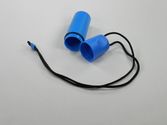
VAS Waterproof Dry Tote - Beach, Boat and Pool
Although we take “waterproof” matches and “waterproof” fire starting blocks with us on the trail – we also take the prudent precaution of putting them both (to include two match striking surfaces from the original match box) in a waterproof case. The criteria that we use to evaluate waterproof match cases are: 1) size of the case, 2) tightness of waterproof seal and 3) having a lanyard on the case. To keep our firestarting supplies dry we use a VAS Waterproof Beach, Boat and Pool Dry Tote instead of a camping supply “match case”. The main reasons for this are that match cases are all really small - with room for ~20 matches and no room for the firestarting blocks, and they don’t normally have a lanyard. The last thing that we want to do in an emergency situation is to lose our matches, so we like having a brightly colored waterproof case tied to our neck or belt when we are making the fire. You can buy this waterproof match case at Amazon.
Although we take “waterproof” matches and “waterproof” fire starting blocks with us on the trail – we also take the prudent precaution of putting them both (to include two match striking surfaces from the original match box) in a waterproof case. The criteria that we use to evaluate waterproof match cases are: 1) size of the case, 2) tightness of waterproof seal and 3) having a lanyard on the case. To keep our firestarting supplies dry we use a VAS Waterproof Beach, Boat and Pool Dry Tote instead of a camping supply “match case”. The main reasons for this are that match cases are all really small - with room for ~20 matches and no room for the firestarting blocks, and they don’t normally have a lanyard. The last thing that we want to do in an emergency situation is to lose our matches, so we like having a brightly colored waterproof case tied to our neck or belt when we are making the fire. You can buy this waterproof match case at Amazon.
Signaling Mirror
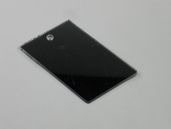
Survive Outdoors Longer 2” x 3” Rescue Flash Mirror
As with the survival whistle, if you are lost and trying to signal rescuers you need a signaling device. To visually signal people, especially people in a plane, the best option is a signaling mirror. The criteria that we use to evaluate signaling mirrors are: 1) visible distance, 2) size, 3) construction material, 4) ease of use, 5) built-in viewfinder/pointing aid and 6) instructions for use printed on mirror. The Survive Outdoors Longer (SOL - the same people that make the "Adventure Medical Kits") Rescue Flash Mirror is great since it can be seen from 20 miles away, weighs 1/3 of an ounce since it is made of a polycarbonate, has a mil-spec retro-reflective aiming aid and includes instructions on the back of the mirror. You can buy this signaling mirror at Amazon.
As with the survival whistle, if you are lost and trying to signal rescuers you need a signaling device. To visually signal people, especially people in a plane, the best option is a signaling mirror. The criteria that we use to evaluate signaling mirrors are: 1) visible distance, 2) size, 3) construction material, 4) ease of use, 5) built-in viewfinder/pointing aid and 6) instructions for use printed on mirror. The Survive Outdoors Longer (SOL - the same people that make the "Adventure Medical Kits") Rescue Flash Mirror is great since it can be seen from 20 miles away, weighs 1/3 of an ounce since it is made of a polycarbonate, has a mil-spec retro-reflective aiming aid and includes instructions on the back of the mirror. You can buy this signaling mirror at Amazon.
Thermal Survival Blanket
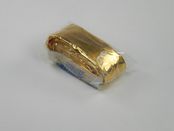
Space Emergency Blanket - 56" x 84"
If you have to unexpectedly spend the night outdoors after something goes awry on a hike then the combination of a poncho and a thermal survival blanket can make the difference between an extremely uncomfortable night (or death in the extreme case) and a tolerable night. The criteria that we use to evaluate thermal survival blankets are: 1) heat reflection/retention, 2) size, 3) weight, 4) water resistance and 5) material durability. We use the Grabber Outdoors Space Emergency Blanket. It retains 80% of the heat, expands to 56" x 84”, is waterproof and windproof, and only weights 3 oz. You can buy this thermal survival blanket at Amazon.
If you have to unexpectedly spend the night outdoors after something goes awry on a hike then the combination of a poncho and a thermal survival blanket can make the difference between an extremely uncomfortable night (or death in the extreme case) and a tolerable night. The criteria that we use to evaluate thermal survival blankets are: 1) heat reflection/retention, 2) size, 3) weight, 4) water resistance and 5) material durability. We use the Grabber Outdoors Space Emergency Blanket. It retains 80% of the heat, expands to 56" x 84”, is waterproof and windproof, and only weights 3 oz. You can buy this thermal survival blanket at Amazon.
Survival Skill Cards
Every year you read about someone lost in the outback without the knowledge to rescue themselves or live through the experience. In many cases these unfortunate people don’t have the proper gear, but sometimes they do have the right gear to help them out of their emergency situation. So what don’t they have? The survival knowledge that they need. Either they forgot it in the crisis situation, or they never knew it. Regardless of how carefully gear is chosen it’s of no use if you don’t know what to do with it.
Because it’s hard to remember everything that you might need to know, having the critical information written down can be extremely helpful. But books are heavy and apps on electronic devices can become inaccessible if your battery dies. Consequently, one set of “cheat sheets” that we have found helpful are Ultimate Survival Technologies (UST’s) “Learn & Live” cards. These laminated cards measure 3.5” x 2.25” inches, weigh less than an ounce and cover a variety of topics to include: Animal Tracking, Bug Out Bag, Clouds, Fire Building, First Aid, Knots, Paracord, Primitive Cooking, Shelter Building, Star Gazing, Survival Fishing and Way Finding. Here are the 5 packets that we have:
Because it’s hard to remember everything that you might need to know, having the critical information written down can be extremely helpful. But books are heavy and apps on electronic devices can become inaccessible if your battery dies. Consequently, one set of “cheat sheets” that we have found helpful are Ultimate Survival Technologies (UST’s) “Learn & Live” cards. These laminated cards measure 3.5” x 2.25” inches, weigh less than an ounce and cover a variety of topics to include: Animal Tracking, Bug Out Bag, Clouds, Fire Building, First Aid, Knots, Paracord, Primitive Cooking, Shelter Building, Star Gazing, Survival Fishing and Way Finding. Here are the 5 packets that we have:
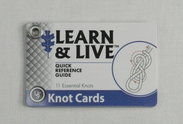
Knots: The 6 cards have instructions and illustrations on how to tie the 11 most commonly used knots. The knots covered are: 1) Double Fisherman, 2) Bowline, 3) Figure Eight, 4) Clove Hitch, 5) Figure Eight Loop, 6) Clove Hitch on a Bight, 7) Prusik Hitch, 8) Square Knot, 9) Trucker’s Hitch, 10) Taut-line Hitch, and 11) Double Sheet Bend. The cards are a perfect reminder for wilderness survival and emergency preparedness.
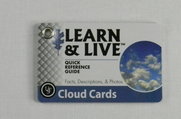
Clouds: The 11 Clouds cards describe the appearance of 10 cloud types along with additional details about elevations and their related weather patterns to assist first-time campers and seasoned backpackers in predicting the imminent weather. The clouds covered are: 1) Cirrus, 2) Cirrostratus, 3) Cirrocumulus, 4) Altostratus, 5) Altocumulus, 6) Nimbostratus, 7) Stratocumulus, 8) Cumulus, 9) Stratus, and 10) Cumulonimbus.
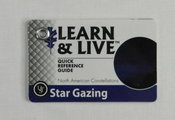
Star Gazing: The 6 Star Gazing cards illustrate and describe the 11 most recognizable constellations in the Northern Hemisphere. Using photographs and detailed descriptions, they’re a great tool to help you recognize the most popular constellations in the night sky. The constellations covered are: 1) Summer Triangle, 2) Ursa Major (e.g. Big Dipper), 3) Ursa Minor (e.g. Little Dipper), 4) Hercules, 5) Draco, 6) Cassiopeia, 7) Pegasus, 8) Corona Borealis, 9) Lupus, 10) Bootes and 11) Orion.
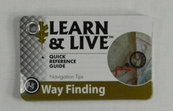
Way Finding: The 10 Way Finding cards describe a variety of navigation tools and provide how-to instructions so you can orient yourself in the outdoors and locate your destination. The cards include examples and step-by-step instructions for using a compass with a map. The topics covered are: 1) Compass and Navigation Basics, 2) Types of Compasses, 3) Holding a Compass, 4) What is a “Bearing”, 5) Using a Compass with Maps, 6) Orienting a Compass with a Map, 7) Plotting a Course, 8) Navigating Around an Obstacle, 9) Finding Your Way Out, 10) Declination: Magnetic North vs. True North, and 11) GPS vs. Digital Compass vs. Analog Compass.
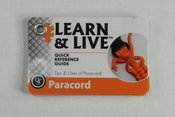
Paracord: The 10 Paracord Cards illustrate and describe a variety of ways to use paracord in emergency situations while hiking and camping. The topics covered are: 1) What is Paracord, 2) Clothing Repair/Replacement, 3) First Aid, 4) Fishing Gear, 5) Food Hanger/Bear Deterrent, 6) Tie Downs, 7) Tent Lash, 8) Clothes Line, 9) Path Marker and 10) Snowshoes.
If you are interested in seeing all of the “Learn & Live” cards that UST makes you can find them here: You can buy the UST "Learn & Live" cards sets at Amazon.